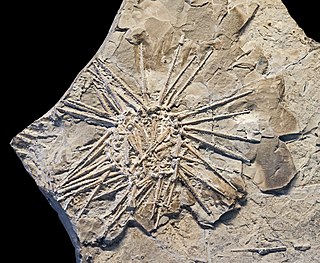
The Montana-class battleships were planned as successors of the Iowa class for the United States Navy, to be slower but larger, better armored, and with superior firepower. Five were approved for construction during World War II, but changes in wartime building priorities resulted in their cancellation in favor of continuing production of Essex-class aircraft carriers and Iowa-class battleships before any Montana-class keels were laid.

In botany, a drupe is an indehiscent type of fruit in which an outer fleshy part surrounds a single shell of hardened endocarp with a seed (kernel) inside. These fruits usually develop from a single carpel, and mostly from flowers with superior ovaries.

USS Texas was a pre-dreadnought battleship built by the United States in the early 1890s. The first American battleship commissioned, she was built in reaction to the acquisition of modern armored warships by several South American countries, and meant to incorporate the latest developments in naval tactics and design. This includes the mounting of her main armament en echelon to allow maximum end-on fire and a heavily-armored citadel amidships to ensure defensive strength. However, due to the state of U.S. industry at the time, Texas's building time was lengthy, and by the time she was commissioned, she was already out of date. Nevertheless, she and the armored cruiser USS Maine were considered advancements in American naval design.

USS Texas (BB-35) is a museum ship and former United States Navy New York-class battleship. She was launched on 18 May 1912 and commissioned on 12 March 1914.

The Colorado-class battleships were a group of four United States Navy super-dreadnoughts, the last of its pre-Treaty battleships. Designed during World War I, their construction overlapped the end of that conflict and continued in its immediate aftermath. Though all four keels were laid, only three ships entered service: Colorado, Maryland, and West Virginia. Washington was over 75% completed when she was canceled under the terms of the Washington Naval Treaty in 1922. As such, the 16" gun Colorado-class ships were the last and most powerful battleships built by the U.S. Navy until the North Carolina class entered service on the eve of World War II.

The Parrott rifle was a type of muzzle-loading rifled artillery weapon used extensively in the American Civil War.

The Type 97 81 mm infantry mortar was a Japanese mortar used primary by Imperial Japanese Army during World War II. The Type 97 designation was given to this gun as it was accepted in the year 2597 of the Japanese calendar (1937). It entered service in 1937. Japanese infantry units often are equipped with 81-mm mortars. The Type 97 81 mm mortar is very commonly used and is referred to by the Japanese as an "Infantry Gun", which breaks down into 3 sections for transport. The markings which appear on the base of the barrel read "97 model small trench mortar."

The 45 mm anti-tank gun model 1937, nicknamed the Sorokapyatka, was a light quick-firing anti-tank gun used in the first stage of the German-Soviet War. It was created by Soviet artillery designer M.N. Loginov of Plant No. 8 after the arrest and execution of former designer V. von Behring. Due to insufficient armor penetration it was replaced in service by the longer-barreled M-42 in 1942. Production of the gun ceased in 1943 with a total of 37,354 units built from 1937 to 1943.
Agathiceras is a subglobose goniatitid from the family Agathiceratidae, widespread and locally abundant in Lower Pennsylvanian to Middle Permian sediments, e.g. the Urals, Sicily, and Texas.
Anatsabites is a monospecific genus of ammonoid cephalopods belonging to the Paragastrioceratidae family. The only species is Anatsabites multiliratus, formerly placed into genus Paraceltites. Its fossils were found in Wordian (Permian) of Texas.

Palmetto State Park is a state park located in Gonzales County, Texas, United States northwest of Gonzales and southeast of Luling. The land was acquired by deeds from private owners and the City of Gonzales in 1934–1936 and was opened in 1936.

The QF 3-inch 20 cwt anti-aircraft gun became the standard anti-aircraft gun used in the home defence of the United Kingdom against German Zeppelins airships and bombers and on the Western Front in World War I. It was also common on British warships in World War I and submarines in World War II. 20 cwt referred to the weight of the barrel and breech, to differentiate it from other 3-inch guns. While other AA guns also had a bore of 3 inches (76 mm), the term 3-inch was only ever used to identify this gun in the World War I era, and hence this is what writers are usually referring to by 3-inch AA gun.

The 14"/45 caliber gun,, whose variations were known initially as the Mark 1, 2, 3, and 5, and, when upgraded in the 1930s, were redesignated as the Mark 8, 9, 10, and 12. They were the first 14-inch (356 mm) guns to be employed with the United States Navy. The 14-inch/45 caliber guns were installed as the primary armament aboard all of the United States Navy's New York-class, Nevada-class, and Pennsylvania-class battleships. The gun also saw service in the British Royal Navy, where it was designated the BL 14 inch gun Mk II.
Cibolites is a genus of ammonoid in the family Paraceltitidae of the cephalopod order Ceratitida which lived during the Late Permian. The genus was first found the Texas and Mexico. The shell is similar to that of Xenodiscites but smooth and with goniatitic sutures.

Prunus rivularis, known variously by the common names creek plum, hog plum, or wild-goose plum is a thicket-forming shrub. It prefers calcareous clay soil or limestone-based woodland soils. This deciduous plant belongs to the rose family, Rosaceae, and is found mainly in the central United States. It is a shrub consisting of slender stems with umbel clusters of white blossoms. The fruit is a drupe that resembles a large berry; though it has a bitter taste, it serves as a source of food for birds and other wildlife. "Prunus" is Latin for plum, whereas "rivularis" means being near a stream.
Tom Harmon, credited as Timothy Scott or Tim Scott, was an American actor.
Agathiceras anceps is a species of Agathiceras, named by Gemmellaro in 1887.
Agathiceras applanatum is a species of Agathiceras, named by Teichert in 1944.
The Bone Spring Formation is a geologic formation found in the Delaware Basin in Texas and New Mexico. It preserves fossils dating back to the Leonardian Age of the Permian Period.

The Canyon Group is a geologic group in Texas. It preserves fossils dating back to the Carboniferous period. It contains the Caddo Creek, Graford, Palo Pinto, Wolf Mountain Shale and Winchell Formations.












